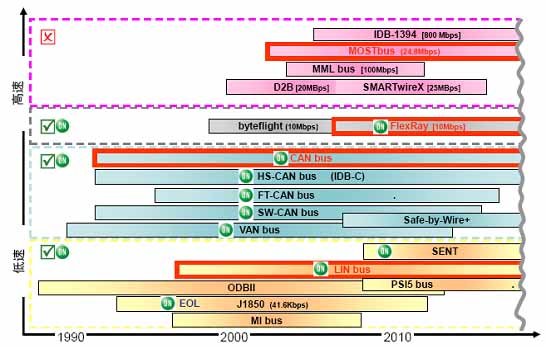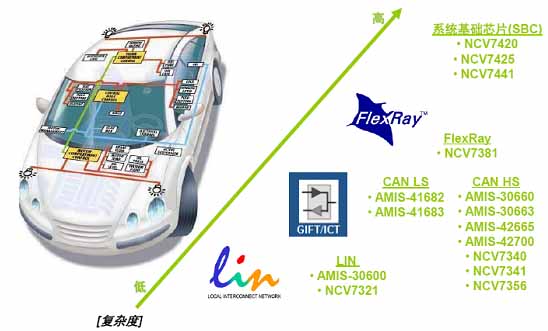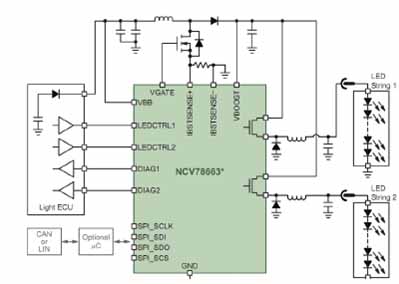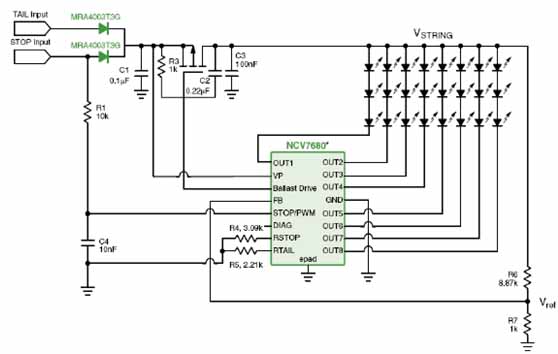In order to achieve energy-saving and emission reduction of automobiles, vehicle manufacturers are sparing no effort to adopt various feasible electronic components, and the effects of these components depend to a large extent on the semiconductor products that make up them. Globally, the average semiconductor content per vehicle in 2010 has reached $262, and will reach $305 in 2013 and $335 in 2017. In comparison, China currently has a lower semiconductor content per vehicle than in Europe, America and Japan, so the development prospects are very impressive. As a leader in providing a wide range of products and solutions, ON Semiconductor designs unique solutions for its customers' system requirements in its key automotive segments, helping customers improve their energy efficiency, reduce energy consumption and achieve environmental impact. Continue to develop.
This article refers to the address: http://
Automotive market environment and its application demand From the automotive market environment, the automotive application semiconductor market is huge, and the growth rate is higher than the average growth rate of the semiconductor market. In 2010 alone, China produced 18.4 million vehicles. These cars have added many new comfort and convenience features, as well as advanced headlamp systems and LED lighting; in addition, due to the impact of hybrid vehicles and future emission regulations, hybrid and pure electric vehicles are on the rise.
ON Semiconductor's key automotive applications for the Chinese market include the automotive network (IVN), automotive infotainment systems and automotive LED lighting. Power management and in-vehicle networking for fuel economy and reduced emissions through engine control, gearbox, and hybrid power; power supplies for microcontrollers, infotainment systems, telematics, body computers, and gateways; lighting includes external (LED, HID, Xenon lights, Advanced Headlight System (AFS), internal (dashboard, door, accent lighting). There are also ASICs for powertrains for engine control, sensors, AC motors, and gearbox control.
ON Semiconductor's Energy-Saving and Emission-Reducing Automotive Solutions ON Semiconductor offers a variety of solutions for automotive applications such as automotive networks, infotainment systems and LED lighting to help automakers meet the standards.
1) In-vehicle network solution In terms of vehicle network, its advantages are to simplify wiring harness and design, reduce cost and vehicle weight; turn traditional power harness into signal harness, improve vehicle safety performance and reduce maintenance cost; with fast diagnosis function It makes production installation and after-sales more convenient; realizes complex control functions and provides almost unlimited software upgrades; facilitates the formation of a unified open electrical platform, adapts to various models, changes in various configurations, and shortens the development cycle. Therefore, at present, international car manufacturers are vigorously introducing CAN network technology. Studies have shown that after using CAN network technology, it is expected to reduce carbon dioxide emissions by about 2.6 g/km in the medium term and 0.11 liters of fuel per 100 km. The evolution of the vehicle network standard is shown in Figure 1.

Figure 1: Evolution of the vehicle network standard
From low to high complexity, ON Semiconductor offers a variety of solutions for different in-vehicle networks such as LIN, CAN, and FlexRay, as shown in Figure 2.

Figure 2: ON Semiconductor's vehicle network solution
2) Infotainment Solutions ON Semiconductor's products for infotainment systems include linear regulators for battery and post regulation, as well as standard/low quiescent current, high power supply rejection ratio (PSRR)/ultra-low static Current, Tracker and Current Sensing; Switching Power Supply (SMPS) for Buck and Boost Controllers/Regulators, Synchronous/Asynchronous Operation, High-Frequency/Low Quiescent Current, Battery and Post-Regulation; Power Management Unit (PMU) with higher integration and optimized size/performance. These products meet the next generation size and energy efficiency requirements.
Advanced power management techniques enable low quiescent current (Iq) power management, sleep wake-up, and energy-efficient power-saving methods. ON Semiconductor's Iq > 60 μA Standard Quiescent Current LDO NCV42xx offers a second source of supply beyond the Infineon TLE42xx device; the NCV85xx is a feature-rich alternative to Infineon/STMicroelectronics/National Semiconductor or similar offerings Device. Very Low Quiescent Current LDO NCV86xx (33 μA < Iq < 50 μA) is pin-for-pin compatible with standard quiescent current devices; ultra-low quiescent current LDO NCV87xx (Iq < 33 μA) and very low quiescent current device pin-to-pin Compatible, can achieve the purpose of energy saving.
Switching power supplies for infotainment system power supplies are available in both buck and boost modes. The former includes the regulator NCV8901/02 series, high-performance controller NCV8851 and low-cost controller NCV3020, LV5749NV and so on. The latter includes high-performance NCV8871 and low-cost NCV3063 boost controllers.
The power management unit NCV8855 has the following features: switching power supply buck controller, 2 A switching power supply buck converter, 2 LDO controllers, 2 A high side switch, frequency up to 600 kHz, 170 kHz, 340 kHz selection, And ROSC or SYNC selection. The NCV8612 is a 3-way LDO output with different voltage/current selection, automatic switching (ASO) functions, and ultra-low quiescent current (Iq) < 50 μA to reduce power dissipation. The NCV8881 features a 1.5 A switching power supply regulated converter, 8.5 V/40 mA/5.0 V/100 mA LDO, ROSC and SYNC and watchdog functions up to 600 kHz.
ON Semiconductor's DSP tuner is a high-performance solution that meets current trends and is suitable for mid- to high-end digital radios. Its unique continuous modulus algorithm (CMA) technology can significantly reduce multi-channel noise and reduce the number of peripheral components (such as coils, diodes, ceramic filters) up to 52. It supports HD broadcast interface, adopts LNA/MIX new design, corresponding to global frequency band, dual tuner adaptive array antenna (adaptive-array-antenna (AAA) technology has matured.
ON Semiconductor also offers the RT-R (Real-time Traffic Information of China) program, which provides road information for taxi feedback in road information feedback systems in 22 cities in China, and then publishes it.
ON Semiconductor's automotive infotainment power solutions range from high performance to low cost solutions for most infotainment systems.
3) Automotive LED lighting solutions
LED lighting has the advantages of high light efficiency, low power consumption, long service life, strong safety and reliability, environmental protection and energy saving. The LED single-tube power is 0.03-0.06 W, which is driven by DC. The single-tube driving voltage is 1.5-3.5 V and the current is 15-18 mA. It reflects fast speed and can be operated at high frequency. When used in the same lighting effect, the power consumption is one ten thousandth of that of incandescent lamps and one-half of fluorescent tubes.
Common automotive LED lighting drive solutions include resistors, linear current regulators (CCRs), linear regulators, and switching regulators. These different solutions have improved energy efficiency, but the complexity is increasing. Among them, the lowest resistance cost, no electromagnetic interference problem, depending on the voltage, the lowest energy efficiency, can simply limit the maximum current of the LED, but the energy efficiency is also the lowest, and there are problems such as LED screening cost and thermal runaway. CCR performance is better than resistors, cost less than linear regulators, no electromagnetic interference problems, wide voltage range, high power density package, LED protection, AEC-Q101 certification, low energy efficiency. Linear regulators have a constant current accuracy of ±2%, multi-line, over-power self-regulation, no EMI problems, moderate cost, and low energy efficiency. The switching regulator has high energy efficiency and requires a dedicated socket. The cost is high and electromagnetic interference is generated.
ON Semiconductor's automotive application LED drivers are very rich. Typical applications for linear regulators are central high-position stop lights, combined taillights (turn signal lights, tail lights, brake lights), side turn signals, and backlights; featuring low current LEDs (~20mA), low total power consumption, up to 85 ̊C Ambient temperature and low system integration. Specific solutions include NSI45xxx (10mA–160mA / 45V) CCR, NUD4001 (500mA/30V) LED drivers and NUD4011 (70mA/200V) LED drivers. Typical applications for switching regulators are internal lighting, combined taillights (light guides), headlamps (first generation) and ambient lights; featuring power LEDs (700 mA), medium to high total energy consumption, up to 125 ̊C environment Temperature and low system integration; specific solutions are NCV3065/6 (1.5 A) constant current LED switching regulator and NCV8871 boost controller. Typical applications for lighting management integrated circuits (LMICs) are headlamps (high beam, low beam, daytime running lights, position lights, turn indicators, fog lights, static turn signals, side marker lights, etc.). Advanced Headlight System (AFS), combined taillights; power LEDs of 700 mA, medium to high total power consumption, suitable for ambient temperatures up to 125 ̊C, complete subsystems; specific solutions for automotive headlamp applications Highly integrated LED controller NCV78663 and linear current regulator for combined taillights and controller NCV7680.
Automotive LED Lighting Examples ON Semiconductor offers a complete range of LED drivers from low current to high current, including discrete, standard and fully custom products, all certified to AEC-Q100. Here are two products as an example to introduce the practical application of LED lighting.
1) Power LED headlight scheme The traditional halogen headlamp power is 55 W, the LED headlight power is only 30W, and the LED headlights can save 45% energy. LED headlamps require support from a single LED to multiple LED strings, voltages up to 60 V, PWM dimming (eg for position lights), energy efficient integrated drivers for low EMC radiation, diagnostics, communication Interface requirements.
ON Semiconductor is currently one of the few semiconductor suppliers to offer LED headlamp solutions. Its NCV78663 power LED headlamp solution (Figure 3) is a system integration solution with few external components and a buck-boost topology; LED current regulator with constant average current, high efficiency integrated buck switching regulator (high-end), current up to 2 A, extended diagnostics, thermal protection; system can be customized by SPI interface and / or OTP settings, a single device supports a variety of system configurations, OEMs are provided with fewer module versions; The EMC is lower, the EMC radiated to the LED string is lower, and the total energy efficiency is high (>90%).

Figure 3: Power LED headlamp solution
2) Combination taillights The combination taillights come in two forms – SuperFlux and SnapLED. ON Semiconductor's NCV7680 linear current regulator can be used for these taillights. It features constant current output for LED string drive, LED open circuit diagnostics, drain output, and æª curvature control to eliminate EMI concerns; low dropout operation for pre-regulator applications, can be used for external modulation; on-chip 1 kHz The trailing edge PWM dimming; the single resistor is used to stop the current set point and the trailing edge dimming set point; the set back power limit under overvoltage and overtemperature conditions, the circuit is shown in Figure 4.

Figure 4: Automotive LED taillight linear current regulator
Summary The focus of ON Semiconductor's automotive business is to leverage ASIC + ASSP + discrete devices = solutions for automotive solutions strategies to enrich engine control, gearbox, hybrid-electric vehicle (HEV) solutions, and infotainment solutions and LED lighting The program meets the need to improve fuel economy and reduce emissions.

Pay attention to ON Semiconductor's official WeChat to learn more innovative and energy-efficient solutions
Mini Cool Mist Usb Air Humidifier
Mini Humidifier is a vase shaped humidifier with lightweight and compact design. With ultrasonic technology, it envelops your surroundings effectively by producing cool mist to add moisture and relieve stress. Suitable for your car, office, bedroom, study room, dining room, children's room and more.
Features
- Mini Cool Mist Humidifier: Designed with high-frequency atomizer plate. It adopts ultrasonic technology to oscillate and decompose water into fine nano-class cool mist molecules, which can quickly penetrate the underlying skin and relieve dry skin.
- User-friendly Design: Lightweight and compact, this Mini Air Humidifier can hold up to 80ml of water and produce up to 25ml of moisture per hour. Both the main engine and water cup are detachable, easy to clean and use.
- Whisper-quiet: Ultra-stable atomizer plate provides gentle and stable mist, creating a quiet and relaxing environment (less than 35dB). Low consumption and low noise make it perfect for sleeping or reading time. Work quietly without producing any bothering noises.
- Safe and Reliable: With the built-in water level sensor, Mini Usb Humidifier will automatically power off when the water level is lower than the safe water level. Compatible with any USB power source (AC power adapters, car chargers, laptops/computers, or power banks), universal and convenient. Safe with a 5V low voltage input.
Mini Humidifier
Mini Humidifier,Mini Usb Humidifier,Mini Air Humidifier,Mini Cool Mist Humidifier
Shenzhen Dituo Electronic Co.,Ltd. , https://www.sz-dituo.com